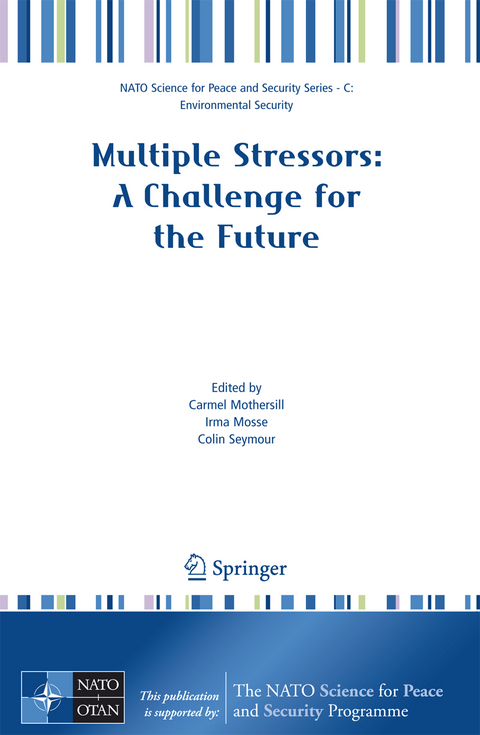
Multiple Stressors: A Challenge for the Future
Springer-Verlag New York Inc.
978-1-4020-6333-6 (ISBN)
Ecotoxiclogical risk from multiple stressors covers any situation where org- isms are exposed to a combination of environmental stressors. These include physical and chemical pollutants as well as other stressors such as parasites and environmental impact (e. g. , climate change or habitat loss). The combi- tion of stressors can result in increased risk to organisms (either additive or synergistic effects) or decreased effects (protective or antagonistic effects). The multiple stressor challenge is an international, multi-disciplinary problem requiring an international, multi-disciplinary approach. The c- rent approach to multiple stressors is to examine one stressor at a time and assume additivity. Little work has been done on combinations of stressors such that potential interactions can be determined. The problem is very complex. Multiple stressors pose a whole spectrum of challenges that range from basic science to regulation, policy and gove- ance. The challenges raise fundamental questions about our understanding of the basic biological response to stressors, as well as the implications of those uncertainties in environmental risk assessment and management. In addition to the great breadth, there is also great depth in the research ch- lenges, largely due to the complexity of the issues. From a basic science point of view, many of the mechanisms and processes under investigation are at the cutting edge of science — involving new paradigms such as genomic ins- bility and bystander effects.
Multiple Stressors: General Overviews.- Challenges in Radioecotoxicology.- The Involvement of Pollution with Fish Health.- Effects of Ionizing Radiation Combined with Other Stressors, on Non-Human Biota.- Ecotoxicology – How to Assess the Impact of Toxicants in a Multi-Factorial Environment?.- A Layperson's Primer on Multiple Stressors.- Multiple Exposure Data – What Responses are Seen?.- Effects of Multipollutant Exposures on Plant Populations.- Methodology of Socio-Ecological Monitoring using Cytogenetic Methods.- Role of Genetic Susceptibility in Environmental Exposure Induced Diseases.- Multiple Stressor Data: Long-Term Effects.- Radiation-Induced Genomic Instability in the Offspring of Irradiated Parents.- Evolution Processes in Populations of Plantain, Growing around the Radiation Sources: Changes in Plant Genotypes Resulting From Bystander Effects And Chromosomal Instability.- Clastogenic Factors, Bystander Effects and Genomic Instability In Vivo.- Post-Radiated and Post-Stressed Volatile Secretions: Secondary Immune and Behavioral Reactions in Groups of Animals.- Multiple Stressors: Mechanisms.- Multidisciplinary Aspects of Regulatory Systems Relevant to Multiple Stressors: Aging, Xenobiotics and Radiation.- Genetic Aspects of Pollutant Accumulation in Plants.- Radiation Risks in the Context of Multiple Stressors in the Environment – Issues for Consideration.- Protection by Chemicals against Radiation-Induced Bystander Effects.- Considerations for Proteomic Biomarkers in Rainbow Trout Ecotoxicology.- Genetic Effects of Combined Action of Some Chemicals and Ionizing Radiation in Animals and Human Cells.- Cytogenetic Biomarkers for Exposure to Multiple Stressors.- Redox Proteomics – A Route to the Identifi cation of Damaged Proteins.- Exposure Assessmentto Radionuclides Transfer in Food Chain.- Radiation, Oxidative Stress and Senescence; The Vascular Endothelial Cell as a Common Target.- Sensitivity of Irradiated Animals to Infection.- Multiple Stressors: Applied Aspects.- Features of Somatic Gene Mutagenesis in Different Age Groups of Persons Exposed to Low Dose Radiation.- State of Ecosystems at Long-term Contamination with Transuranium Radionuclides.- Technologically Enhanced Naturally Occurring Radioactive Materials (TENORM) in Non-Nuclear Industry and Their Impact Into Environment and Occupational Radiation Risk.- Steppe Soils Buffer Capacity and the Multipollution Impact of Industrial Enterprises in Ukraine.- Cancer Risk Assessment in Drinking Water of Izmir, Turkey.- Enhanced Adsorption of Atrazine in Different Soils in the Presence of Fungal Laccase.- Problem of Microelementoze and Technology Allowing its Elimination with the Help of Geothermal Mineralized Sources: New Technology of Microelentoze Elimination.- Ecology-related Microbiological and Biochemical Parameters in Assessing Soils Exposed to Anthropogenic Pollution.- Molecular and Cellular Effects of Chronic Low Dose-Rate Ionizing Radiation Exposure in Mice.- Multiple Stressors – Risk Assessment and Legal/Ethical Aspects.- Modeling the Best Use of Investments for Minimizing Risks of Multiple Stressors on the Environment.- Learning from Chernobyl: Past and Present Responses.- Uncertainties from Multiple Stressors: Challenges in Ecological Risk Assessment.- Nuclear Pollution Exposure and Risk Assessment – The Case of Nuclear Reactors Accidents Involving Radioactive Emission.- Multiple Stressors and the Legal Challenge.
| Erscheint lt. Verlag | 20.8.2007 |
|---|---|
| Reihe/Serie | NATO Science for Peace and Security Series |
| Zusatzinfo | XX, 484 p. |
| Verlagsort | New York, NY |
| Sprache | englisch |
| Maße | 155 x 235 mm |
| Themenwelt | Naturwissenschaften ► Biologie ► Ökologie / Naturschutz |
| Naturwissenschaften ► Geowissenschaften | |
| Recht / Steuern ► EU / Internationales Recht | |
| Recht / Steuern ► Öffentliches Recht ► Umweltrecht | |
| Technik ► Umwelttechnik / Biotechnologie | |
| ISBN-10 | 1-4020-6333-4 / 1402063334 |
| ISBN-13 | 978-1-4020-6333-6 / 9781402063336 |
| Zustand | Neuware |
| Informationen gemäß Produktsicherheitsverordnung (GPSR) | |
| Haben Sie eine Frage zum Produkt? |
aus dem Bereich


